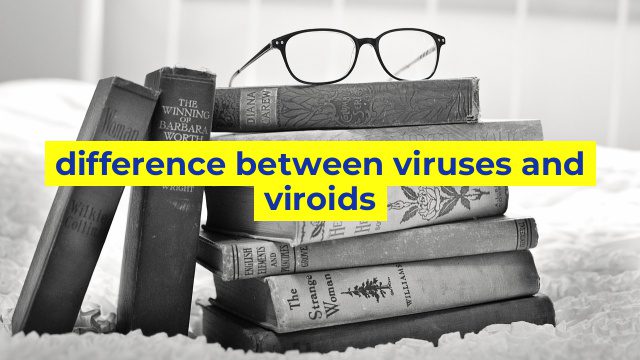The Significant Difference between Viruses and Viroids
Viruses and viroids are the two terms that we often hear when we talk about infectious diseases. While viruses are known to be the most common causes of such diseases, viroids are still a new and emerging field of study. Both of these infectious agents are capable of causing various diseases in animals and plants, but they have numerous differences in terms of their size, structure, genetic material, and disease-causing mechanisms.
Size and Structure
Viruses are larger in size and more complex in structure than viroids. They consist of genetic material, either RNA or DNA, surrounded by a protein coat called a capsid. Some viruses have an additional outer lipid envelope derived from the host cell membrane. Viroids are much smaller, consisting only of highly structured, circular RNA molecules that lack any protein coat or envelope.
Genetic Material
The genetic material of viruses can either be RNA or DNA, but they cannot have both. They replicate by integrating with the host cell’s genetic material and, as a result, hijack the cell’s machinery to produce new viral particles. In contrast, viroids only contain RNA that directly interferes with the host cell’s metabolic processes, leading to disease symptoms.
Disease-Causing Mechanisms
Viruses and viroids cause disease in different ways. Most viruses cause disease by infecting and destroying host cells directly or by eliciting an immune response, resulting in an inflammatory response. Viroids cause disease by inducing RNA interference or gene silencing, resulting in the disruption of normal gene expression and metabolism in the host cell.
Treatment and Prevention
Treatment and prevention of infectious diseases caused by viruses and viroids depend on several factors, including the type of virus or viroid, its pathogenicity, and the host’s immune response. Vaccines are available for many viral diseases and can prevent them from occurring. However, there are currently no vaccines for viral infections caused by newly emerging viruses or for viroid diseases due to the lack of effective antiviral drugs.
Conclusion
In conclusion, viruses and viroids are two different types of infectious agents that differ in terms of their size, genetic material, and disease-causing mechanisms. Although they both cause diseases, they pose different challenges in terms of prevention and control. Therefore, it is essential to understand their unique features and mechanisms to develop effective therapies and vaccines against these infectious agents.
Table difference between viruses and viroids
| Category | Viruses | Viroids |
|---|---|---|
| Size | Large: typically over 50 nm in diameter | Small: typically less than 0.1 μm in diameter |
| Structure | Structured: contain genetic material (DNA or RNA) surrounded by a protein coat | Unstructured: contain only RNA, with no protein coat |
| Replication | Require a host cell to replicate | Self-replicate within the host cell |
| Disease | Cause many human and animal diseases, such as HIV, influenza, and Ebola | Cause only plant diseases |
| Treatment | Can be treated with antiviral drugs and vaccines | No specific treatment is available |

